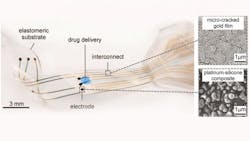Making Spinal Connections with Flexible Implants
Advances in spinal repair will allow people to regain movement and sensation by using cracked gold. Developed by Professors Stephanie Lacour and Gregoire Courtine at the Centre for Neuroprosthetics at Switzerland’s École Polytechnique Fédérale de Lausanne, the e-Dura implant is specifically designed for use on the surface of brain or spinal cord implementation. This small device can imitate the mechanical properties of living tissue, delivering electric impulses and pharmacological substances to the brain or spine.
The implant is as flexible and stretchable as living dura tissue matter. The e-Dura is comprised of a silicon substrate covered with cracked gold electric conducting tracks that can be pulled and is stretchable. “If we introduce micro cracks that are randomly distributed, then the gold ligaments that are between the cracks form a continuous structure that can withstand the deformation,” according to Lacour, adding that when the structure is pulled on, “the micro cracks open and rearrange themselves, and the gold in between is not strained.”
Watch "Flexible Neural Implant Allows Paralyzed Rats to Walk Again," curated by Engineering TV, below:
The electrodes are made of composite silicon and platinum microbeads. They can bend and deform in any direction. The delivery of the pharmacological substances is performed via a fluidic microchannel (neurotransmitters) that reanimate the nerve cells. Lacour notes that the “e-Dura implant can remain for a long period of time on the spinal cord or the cortex, precisely because it has the same mechanical properties as the dura mater itself.” Prior surface implants did not have a long lifespan due to the rigid material rubbing against dura matter (i.e., the nervous system’s protective envelope). This leads to inflammation, scar tissue buildup, and rejection.
The initial tests are being conducted on paralyzed rats. Not only was the implant biocompatible with the rats, but with only a few weeks of training, they were able to walk again. The implant monitors electrical impulses from the brain in real time. The team of scientists was able to extract the rat’s motor intention prior it being translated into movement.
One of the current obstacles facing the implant is control of the impulses sent. The current implant is controlled outside of the rat by the team. They would need to develop a connection to the brain so the movement could be voluntary and decided by the individual. A small and wireless transmitter in a titanium casing that could reside within the body is one possible solution. Another obstacle is FDA approval. While platinum gold and silicon are biocompatible, each individual component used in the device must still be approved by FDA for human use.
The potential for the device is great. The device can be used on any part of the nervous system. Flexible electronics could be placed under the skin to restore tactile senses for amputees or diabetics who have lost touch and feel. Applying the device to the surface of the brain could help patients who suffer from Parkinson’s disease or provide alerts for incoming seizures in epileptics.
